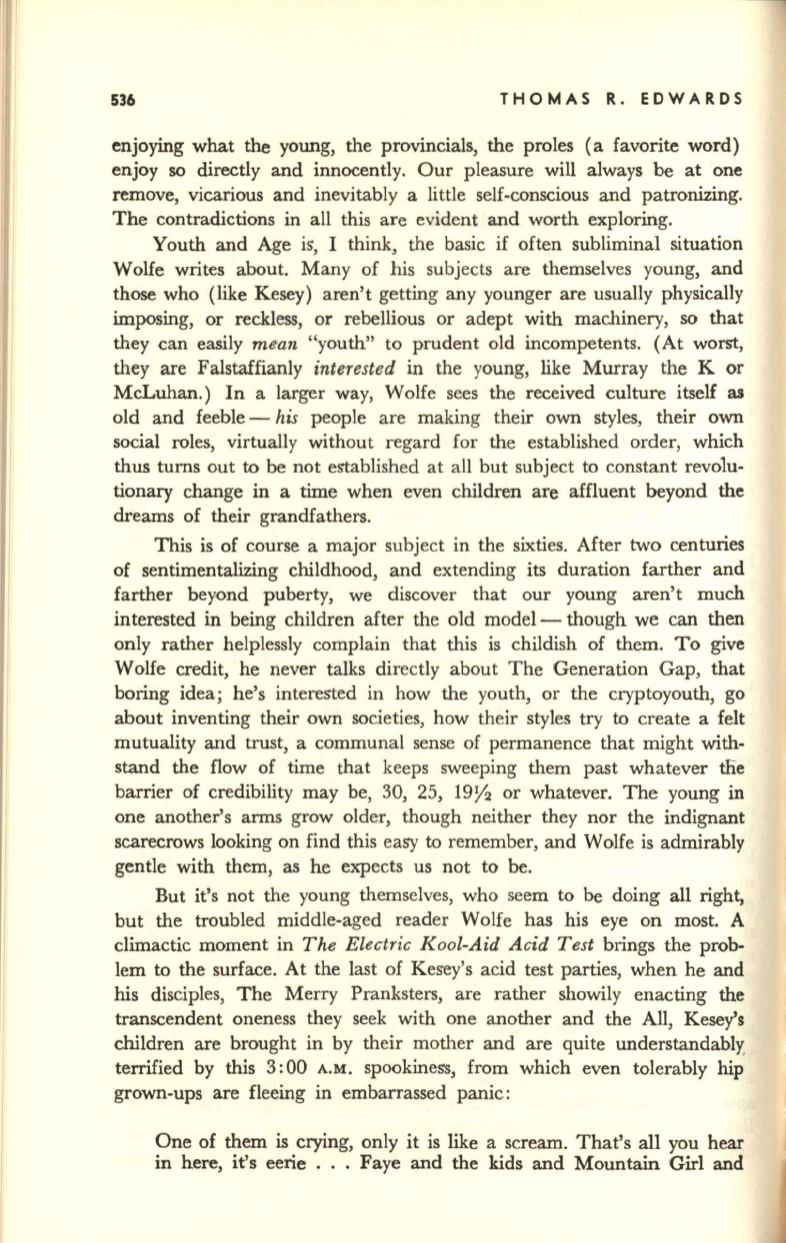
536
THOMAS R. EDWARDS
enjoying what
the
young, the provincials, the proles (a favorite word)
enjoy so directly and innocently. Our pleasure will always be at one
remove, vicarious and inevitably a little self-conscious and patronizing.
The contradictions in all this are evident and worth exploring.
Youth and Age is, I think, the basic if often subliminal situation
Wolfe writes about. Many of his subjects are themselves young, and
those who (like Kesey) aren't getting any younger are usually physically
imposing, or reckless, or rebellious or adept with machinery, so that
they can easily
mean
"youth" to prudent old incompetents. (At worst,
they are Falstaffianly
interested
in the young, like Murray the K or
MeLuhan.) In a larger way, Wolfe sees the received culture itself as
old and feeble -
his
people are making their own styles, their own
social roles, virtually without regard for the established order, which
thus turns out
to
be not established at all but subject to constant revolu–
tionary change in a time when even children are affluent beyond the
dreams of their grandfathers.
This is of course a major subject in the sixties. After two centuries
of sentimentalizing childhood, and extending its duration farther and
farther beyond puberty, we discover that our young aren't much
interested in being children after the old model- though we can then
only rather helplessly complain that this is childish of them. To give
Wolfe credit, he never talks directly about The Generation Gap, that
boring idea; he's interested in how the youth, or the cryptoyouth, go
about inventing their own societies, how their styles try to create a felt
mutuality and trust, a communal sense of permanence that might with–
stand the flow of time that keeps sweeping them past whatever tlie
barrier of credibility may be, 30, 25,
19J!2
or whatever. The young in
one another's arms grow older, though neither they nor the indignant
scarecrows looking on find this easy
to
remember, and Wolfe is admirably
gentle with them, as he expects us not to
be.
But it's not the young themselves, who seem to
be
doing all right,
but the troubled middle-aged reader Wolfe has his eye on most. A
climactic moment in
The Electric Kool-Aid Acid Test
brings the prob–
lem to the surface. At the last of Kesey's acid test parties, when he and
his disciples, The Merry Pranksters, are rather showily enacting the
transcendent oneness they seek with one another and the All, Kesey's
children are brought in by their mother and are quite understandably,
terrified by this 3: 00
A.M.
spookiness, from which even tolerably hip
grown-ups are fleeing in embarrassed panic:
One of them is crying, only it is like a scream. That's all you hear
in here, it's eerie ... Faye and the kids and Mountain Girl and


